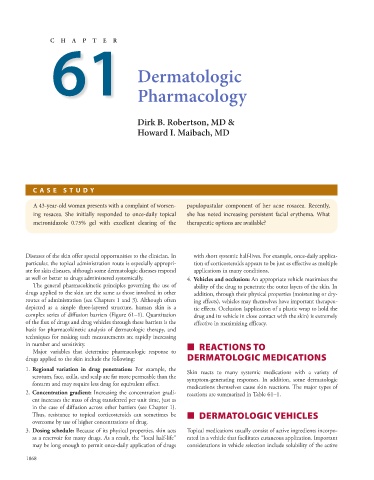Page 1082 - Basic _ Clinical Pharmacology ( PDFDrive )
P. 1082
61 Dermatologic
C H A P T E R
Pharmacology
Dirk B. Robertson, MD &
Howard I. Maibach, MD
C ASE STUD Y
A 43-year-old woman presents with a complaint of worsen- papulopustular component of her acne rosacea. Recently,
ing rosacea. She initially responded to once-daily topical she has noted increasing persistent facial erythema. What
metronidazole 0.75% gel with excellent clearing of the therapeutic options are available?
Diseases of the skin offer special opportunities to the clinician. In with short systemic half-lives. For example, once-daily applica-
particular, the topical administration route is especially appropri- tion of corticosteroids appears to be just as effective as multiple
ate for skin diseases, although some dermatologic diseases respond applications in many conditions.
as well or better to drugs administered systemically. 4. Vehicles and occlusion: An appropriate vehicle maximizes the
The general pharmacokinetic principles governing the use of ability of the drug to penetrate the outer layers of the skin. In
drugs applied to the skin are the same as those involved in other addition, through their physical properties (moistening or dry-
routes of administration (see Chapters 1 and 3). Although often ing effects), vehicles may themselves have important therapeu-
depicted as a simple three-layered structure, human skin is a tic effects. Occlusion (application of a plastic wrap to hold the
complex series of diffusion barriers (Figure 61–1). Quantitation drug and its vehicle in close contact with the skin) is extremely
of the flux of drugs and drug vehicles through these barriers is the effective in maximizing efficacy.
basis for pharmacokinetic analysis of dermatologic therapy, and
techniques for making such measurements are rapidly increasing
in number and sensitivity. ■ REACTIONS TO
Major variables that determine pharmacologic response to
drugs applied to the skin include the following: DERMATOLOGIC MEDICATIONS
1. Regional variation in drug penetration: For example, the Skin reacts to many systemic medications with a variety of
scrotum, face, axilla, and scalp are far more permeable than the symptom-generating responses. In addition, some dermatologic
forearm and may require less drug for equivalent effect. medications themselves cause skin reactions. The major types of
2. Concentration gradient: Increasing the concentration gradi- reactions are summarized in Table 61–1.
ent increases the mass of drug transferred per unit time, just as
in the case of diffusion across other barriers (see Chapter 1).
Thus, resistance to topical corticosteroids can sometimes be ■ DERMATOLOGIC VEHICLES
overcome by use of higher concentrations of drug.
3. Dosing schedule: Because of its physical properties, skin acts Topical medications usually consist of active ingredients incorpo-
as a reservoir for many drugs. As a result, the “local half-life” rated in a vehicle that facilitates cutaneous application. Important
may be long enough to permit once-daily application of drugs considerations in vehicle selection include solubility of the active
1068

